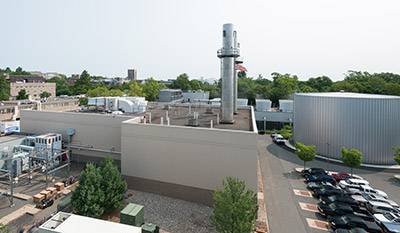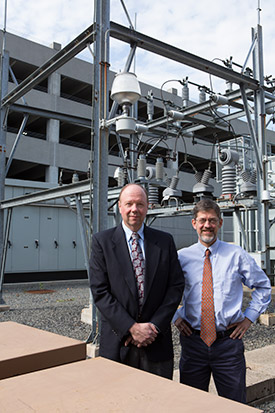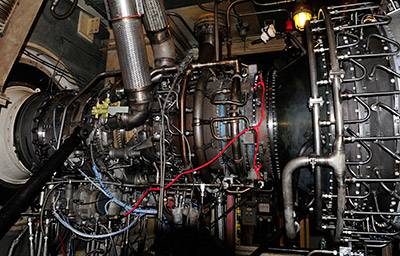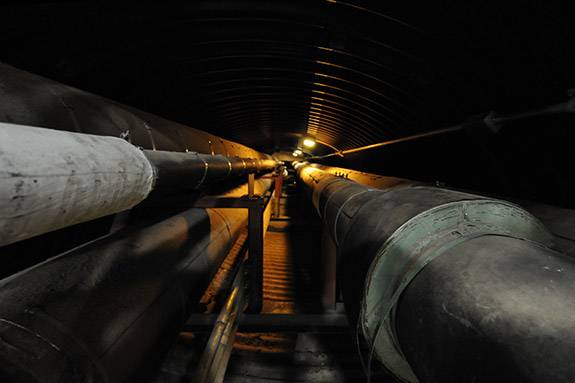In the nearly two years since Hurricane Sandy hit New Jersey, darkening swaths of the nation's most densely populated state for days, Princeton University has emerged as a national example of how to keep power running for residents, emergency workers and crucial facilities when the next disaster strikes.
Specifically, attention has fallen on Princeton's "microgrid," an efficient on-campus power generation and delivery network that draws electricity from a gas-turbine generator and solar panel field southeast of campus in West Windsor Township, New Jersey. Capable of producing 15 megawatts (or 15 million watts) of electricity, the University's microgrid enjoys a give-and-take relationship with the main grid available to the general public and maintained by the utility company PSE&G. When campus power use is high or utility power is inexpensive, the microgrid draws from the PSE&G grid, and when campus demand is low, Princeton's microgrid can contribute power to the main grid.
But in times of crisis the University microgrid is able to disconnect completely and generate all the power for campus — even when everything around it is dark. Late on the night of Oct. 29, 2012, after Hurricane Sandy knocked out power for the immediate area, the University was dark for about 20 minutes, recalled Ted Borer, Princeton's energy plant manager. PSE&G restored power long enough for Princeton to restart its gas turbine, a natural gas-fed, fighter jet-style engine that can produce enough heat and electricity for 12,000 people.

The heart of the Princeton microgrid is the cogeneration plant (center), which was constructed in 1996. The plant produces electricity as well as steam used for heat, hot water and sterilization. The plant also runs the industrial "chillers" that cool the 2.6 million gallons of water used to cool campus buildings and research instruments such as computer servers, lasers and medical scanners. (Photo by Christopher Lillja, Facilities Organization)
When the utility grid soon went out again, the turbine, now disconnected from the PSE&G grid and running at 13 megawatts to avoid overburdening it, powered the campus until the University reconnected with the main grid shortly before midnight on Oct. 31. In the meantime, the University served as "a place of refuge," with police, firefighters, paramedics and other emergency-services workers from the area using Princeton as a staging ground and charging station for phones and equipment, Borer said. Local residents whose homes lost power also were invited to warm up, recharge phones and other electronic devices and use wireless Internet service at a hospitality center that was opened on campus at the request of the Princeton municipal emergency operations center.

One benefit of a microgrid is the ability to incorporate renewable energy. About 5.5 percent of the University microgrid's power comes from a solar panel field southeast of campus in West Windsor Township, New Jersey. (Photo by Christopher Lillja, Facilities Organization)
"For a day and a half, we had to generate everything the campus needed," Borer said. "We didn't know about Hurricane Sandy 20 years ago [when the microgrid was first established], but we knew there are things that make the [utility-company] grid unreliable … Now, we can run the campus as an electric island in times of crisis."
That capability is the main reason that people such as Tom Nyquist, the executive director of engineering and campus energy in Princeton's Facilities Organization, have spent the past two years speaking with reporters, hosting visitors from government and the private sector, and attending conferences where the Princeton microgrid is touted.
Microgrids are common at large institutions such as hospitals and universities, Nyquist said. Hurricane Sandy, however, produced a confluence of factors wherein millions of people lost power for an extended period of time, while a prominent institution pulled through, Nyquist said.

During the past two years, with recognition of Princeton's ability to power itself and serve as a resource to the community and emergency workers during Hurricane Sandy, Tom Nyquist (left), the executive director of engineering and campus energy in Princeton's Facilities Organization, and Ted Borer (right), Princeton's energy plant manager, have been speaking with reporters, hosting visitors from government and the private sector, and attending conferences where the Princeton microgrid is touted. (Photo by Denise Applewhite, Office of Communications)
"I am constantly getting told that we are getting held up by various people pushing for microgrids, mostly at the federal level," Nyquist said.
"There were a lot of people out there looking at microgrids before Sandy. Then the storm hit New Jersey and we kept the lights on. Then people said, 'Wow, it really does work,'" he said. "We've had a lot of hurricanes since we built the plant, but Sandy was different and got us much more exposure. From a resiliency standpoint, many universities are doing the same thing, but we happen to be in the crosshairs because of Sandy."
The "crosshairs" of that recognition has included meetings with each of the five commissioners of the Federal Energy Regulatory Commission in 2013, visits from the last three presidents of the New Jersey Board of Public Utilities, and walk-throughs with developers working to construct microgrids in other cities such as Bridgeport, Connecticut, Nyquist said. At one point, an official from the International District Energy Association, an energy trade group, told Nyquist that "people want what Princeton has," he said. "It's a nice thing to hear," he said. "The communities themselves have heard Princeton rode through Sandy. They want to ride through the next one too, and so they want the same system."
Instead, Nyquist and his colleagues have worked to encourage and help those interested in microgrids to seriously consider their specific needs, which may differ greatly from the University's. In addition, while "resiliency" has been the word on people's minds, Nyquist said he has used the recognition from Sandy to promote the microgrid's other, in a way, more significant, benefits — namely, cost efficiency, reduced environmental impact and the opportunity to use renewable energy. Nyquist and Borer are founding co-chairs of the Microgrid Resources Coalition, a national organization that seeks to advance microgrids as energy resources and advocates for fairness in regulations and market access associated with microgrids.

On a tour of the University energy plant, Borer (left) explains the environmental and financial benefits of cogeneration to students. The microgrid is centrally managed from a control room in the cogeneration plant. When campus power use is high or utility power is inexpensive, the microgrid draws from the main grid maintained by the utility company PSE&G, and when campus demand is low, Princeton’s microgrid can contribute power to the main grid. (Photo by Denise Applewhite, Office of Communications)
"Some people are looking at microgrids from a resiliency point of view, but we feel that it's more beneficial to look at it from all angles and maximize the potential of the microgrid," Nyquist said. "You can get the resiliency piece, but you may as well go for the economic piece, too, and if you can get renewables you can do even better."
A unique feature of the Princeton microgrid is what's known as a real-time energy dispatch system, meaning that the University pays for power based on how much it actually costs at a given time of day. Princeton power engineers are able to adjust how much power comes from the main grid based on how prices fluctuate during the day.
When campus demand is high and power is expensive (usually at midday), the power the microgrid takes from the PSE&G grid is reduced, Borer said. At night, when power demand is low and electricity is cheaper to buy than to produce on campus, power coming from the main grid is increased. Campus usage averages 16 megawatts, leaping to as high as 27 megawatts on a hot day and falling to as low as 10 megawatts at night, Borer said. One important nighttime use is chilling the 2.6 million gallons of water used to cool campus buildings and research instruments such as computer servers, lasers and medical scanners, Borer said.

The cogeneration plant's main power generator is run by the gas turbine (pictured), a natural gas-fed, fighter jet-style engine that can produce enough heat and electricity for 12,000 people. The exhaust from the turbine is used to heat a boiler that produces the steam used across campus. (Photo by Christopher Lillja, Facilities Organization)
The heart of the Princeton microgrid is the cogeneration plant, primarily powered by the gas turbine; about 5.5 percent of power comes from the solar panel field. The cogeneration plant produces electricity as well as steam — produced by a boiler heated with the exhaust of the gas turbine — used for heat, hot water, sterilization, and running the industrial "chillers" that cool the chilled water. Heating and cooling for all of the roughly 180 University buildings is generated on campus and provided via the steam boilers and chilled water plant. The cogeneration plant was constructed in 1996 when Princeton replaced the coal-fired boilers that had been in place since the 1920s and produced steam that turned a power turbine, Borer said. The Princeton cogeneration plant is 75 to 85 percent efficient, compared with 25 to 50 percent efficiency for central utility-company power generation, Borer said.

Steam tunnels carry steam produced at the cogeneration plant throughout campus. Heating and cooling for all of the roughly 180 University buildings is generated on campus and provided via steam boilers and the chilled water plant. (Photo by Christopher Lillja, Facilities Organization)
A longtime power engineer, Borer is encouraged by the attention microgrids have received since the University's performance during Hurricane Sandy. Microgrids are simply more efficient for places that have them and for the overall power system, he said.
"This microgrid is not unique, but it is less common and is something that for many, many reasons we think should be more common," Borer said. "They're much less common than what would be helpful to us as a state and a nation."




